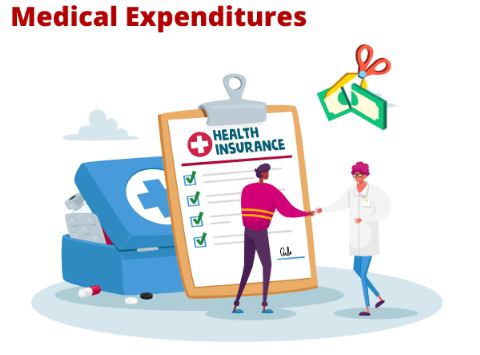Well-Being and Medical Expenditure (GS Paper 3, Economy)

Introduction
- Recent data from the Household Consumption Expenditure Survey 2022-23 highlights a notable decline in poverty rates since 2011-12.
- However, focusing solely on poverty may overlook a critical aspect of welfare: households’ vulnerability to adverse shocks, such as significant medical expenses.
- A household's ability to cope with such shocks is integral to its overall well-being, yet quantifying this resilience remains complex.
Medical Expenditure as a Household Shock
Economic Burden of Health Shocks:
- Health shocks, which include unexpected medical emergencies or prolonged illnesses, significantly impact household finances.
- The resulting medical expenditure often diverts resources away from other essential needs, such as food and housing.
- This financial strain can lead to reduced quality of life and increased vulnerability, as families may be forced to cut back on other expenditures to manage healthcare costs.
Quantifying the Impact
Objective:
- The primary aim is to illustrate how high medical spending due to hospitalisation can constrain households' ability to allocate resources for other critical needs, potentially affecting their overall consumption status and well-being.
Data on Health Expenditure
Incidence of Hospitalisation Expenditure:
- Overall Increase: The proportion of households in the bottom 50% of the income distribution that incurred hospitalisation expenditure increased from 17% in 2011-12 to 22% in 2022-23.
- Rural vs. Urban: For rural households, the incidence rose from 18% to 23%, while for urban households, it increased from 16% to 20%. This trend suggests improved healthcare accessibility for poorer populations across both settings.
Ratio of Health Expenditure to Household Expenditure:
Without Hospitalisation:
- The health expenditure ratio (as a percentage of total household expenditure) for households without hospitalisation increased slightly from 3.3% in 2011-12 to 3.6% in 2022-23.
With Hospitalisation:
- For households experiencing hospitalisation, this ratio declined from 10.8% to 9.4% over the same period. This decrease indicates a relative reduction in the financial burden of hospitalisation.
Rural Areas:
- In rural settings, households without hospitalisation saw a minor increase in health expenditure ratio from 3.4% to 3.6%.
- Conversely, for those with hospitalisation, the ratio significantly decreased from 11.15% to 9.14%.
- This trend points to improving affordability of healthcare in rural regions.
Change in Consumption Status
Impact of Health Expenditure on Consumption:
- 2011-12: Among the poorest 50%, 40% of households that experienced hospitalisation saw a decline in their consumption status due to the financial strain.
- 2022-23: By contrast, this figure decreased to 33% despite the increased incidence of hospitalisation, reflecting a positive shift in the ability of these households to maintain their consumption levels even with rising healthcare costs.
Conclusion
Improvements in Healthcare Accessibility:
- Over the past decade, there has been a marked improvement in the accessibility and affordability of healthcare for the bottom 50% of the Indian population.
- The financial burden of hospitalisation has reduced, with fewer households experiencing a decline in their consumption status due to medical expenses.
- Rural vs. Urban Trends: These improvements are particularly notable in rural areas, suggesting targeted efforts to enhance healthcare accessibility in less developed regions.
- Role of Ayushman Bharat Yojana: The trends observed align closely with the objectives of the Ayushman Bharat Yojana, which aims to provide financial protection against high medical expenses for vulnerable populations.
- Overall, the data indicates a positive trend in healthcare affordability and resilience among the poorest households, underscoring the effectiveness of recent policy interventions and improvements in healthcare infrastructure.


